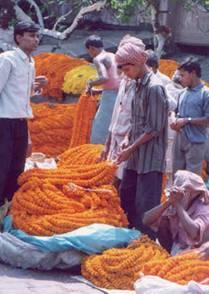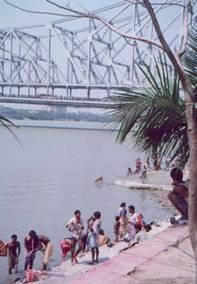
Lost in India – 6. KALI’S BLACK LAMB
6. KALI’S BLACK LAMB (March 22–24, 2000)
“Go to Calcutta. My father would love to see you again. I have talked to him. He is thinking of taking you to his tea estates in Orissa. You will like it,” Bharat Dube had insisted in Geneva.
I had taken a guided tour of Calcutta in December 1994 on my way back from Nepal. I had walked in the throngs of people during the evening rush. I have seen Calcutta in the film, “City of Joy”! Mother Theresa’s mission did not attract me to it. I did not want to be found yet! I wanted to take a train from Patna and go south across Bihar and Orissa straight to Bhubaneswar and Puri on the eastern coast of Orissa. Alas, there is no such easy shortcut; the quickest route is through Calcutta.
“There is a comfortable hotel walking distance from where I live”, said Basant Dube when I phoned him. “The rate is about seven thousand rupees, bed and breakfast.” When I told him how I was traveling he booked me in Lytton Hotel on Sudder Street at two thousand rupees including luxury tax. This is about five times the highest rate I paid during my trip.
Sahara Air flew me from Patna to Calcutta. Before I was tempted to lapse in the snug air-conditioned room, I decided to venture out to the Maidan, the Hyde Park of the city and see the sunset and get a feel of the streets. On reflection I felt that I should have left out Calcutta from my itinerary.
It was seven thirty. I was hungry. My “Lonely planet” guidebook directed me to eat at Khwaja or Khalsa restaurant, both on Sudder Street. My last try to phone Basant found him.
Dinner was waiting. A fifteen-minute walk in the warm evening, probably cold for the Bengalis, brought me to an old colonial office/residential building. An elderly caretaker took care of me and drove his rickety lift to the apartment bearing at least two very prestigious looking signboards. I crossed a wide office buzzing with fax machines and computers into Basant’s residential quarters.
The interior decor is a nostalgia of British colonial times. Phone calls and clerks seeking Basant’s attention, approbation and signatures frequently interrupted our dinner. We agreed to meet the next evening at five; it was not convenient for him to visit the tea estates.
Basant reminded me, “Kali Temple is worth a visit. Darshan(vision) of the statue of goddess herself is a must”. I had other much simpler plans. Next morning at six-thirty I crossed Nehru Road into The Maidan which was engulfed in a thick morning haze. I jogged aimlessly southwards feeling proud of being an early bird. In less than a minute I was pleasantly surprised to see youths playing a full-scale cricket match, then another and another. I zigzagged around their unmarked pitches. On the way back I tried to get into Fort William, but an army guard abruptly straightened his gun across my path. Since the British rebuilt it in 1781, it has remained in the hands of the Army and even its surrounding area is out of bound. After a short pleasant chat with the Jawan (soldier) I crossed the Maidan back to my hotel sweating profusely. A relaxing shower followed by a copious English-Bengali buffet breakfast made me feel mighty brave ready to confront the potent and fearful Kali Mata.
A Sikh taxi driver, originally of Mohi village near Mulapur (Ludhiana), landed me near Kalighat Mandir. He cautioned me, “Watch out pundits; they will ask you for big money for Kali Devi darshan“. Seeing a big throng trying to enter the temple, I decided to circumambulate it, naturally barefoot. At the back, I saw a hefty stocky man enter a quaint fenced square carrying under his arm a lovely young black lamb. Its soft pelt glimmered even in the dull sun. Its eyes emanated the purest innocence I have ever seen. That image remains imprinted in my mind. What a contrast to the flaming eyes of Kali! Starkly casual, the man sprinkled holy water on its forehead. In a flicker of my eyelid he turned round, placed its head between two stakes, chopped off its godly head and offered his bloody finger to touch foreheads of spectators. I wonder how much innocence has been sacrificed and yet goddess Kali’s blood lust has not been quenched.
According to Hindu mythology, Shiva’s first wife, Shakti, had transgressed. Was it adultery? She was punished. Her body was strewn over India. One of her fingers fell at Kalighat (hence Calcutta). Her “yoni” fell at Gawahati in Assam where in mid-year Hindus celebrate the end of the earth’s menstrual cycle. The menstrual blood is derived from lamb sacrifice. Why don’t they chop off human lingums(phalluses) instead?

Calcutta’s rubbish cleaning system!
To quell my anti-Kali sentiments I decided not to see her at all and walked to the Metro that took me to Gandhi Road stop, the nearest point to Hawrah Bridge. Unhurriedly and aimlessly I paced through the bazaar towards Hoogly River. Approaching a small crossroad even my insensitive nose encountered a blast of pungent smell. A big tractor was shovelling a three-metre high pyramid of rubbish into a truck. How long it has been accumulating only the seagulls picking maggots from it could tell.
Crossing the Strand and the railway line I landed in the flower market. Piles of strings of fresh marigolds look immensely better than in the photo.

Flower market
Slow walking made my rusty knees stiff. Yet I could not resist the temptation of walking across and see the world’s most frequently crossed bridge. I am glad I did it. I would have missed a unique encounter with men and women of all ages carrying farm produce and other merchandise usually on head. Humanity, rather than humanness, on the move! I just watched, watched, walked limply and descended to the equally famous Howrah railway station. Inside the station, I sat on a railing. Greedily I pulled out a bun from my small backpack. I had received it as prasad in Patna Sikh Temple the previous day. It was big not too sweet but tasted heavenly. Chasing it down with mineral water bought from the nearby stall, I had mini bananas for desert. I watched country people sitting on the floor in groups waiting for their train. Others shuffled from one platform to another. Couples of college students sat just close enough to each other not to be noticed and romantically shared lunch. An hour passed in perfect bliss.

Spectacular view of half-a-kilometre long single-span Howrah Bridge from the popular bathing ghat.

Hoogly baths!
I walked out through the riverside gate and joined people lined up to board a ferry. The ferry took me across the Hoogly back to Strand at Babu Ghat. Again I walked across The Maidan and passed by a sports
club where I stopped briefly to rest and watch a field hockey match.
After a refreshing quick shower I was out and sweating again marching to Basant Dube’s residence. I had some time to spare. On the way, I visited the Indian Museum. Its huge galleries display the finest collection of archaeological, historical, cultural, and natural history artefacts.
As we had agreed, I rang the bell exactly at five. Basant’s cook received me hospitably and I landed into a comfortable sofa. Directing the fan at me he announced that sahib was playing tennis and would be coming soon.
A blessing in disguise: I rested for a good hour before Basant turned up and was lost again for half an hour in his bath room. Just when he was pouring our whiskies a charming smiling lady walked in wearing a bright sari and matching jewellery. Her husband, she said, was occupied so she had come alone. She claimed her gin tonic and unhesitatingly provided the feminine touch the evening needed.
Bose is a common Bengali family name. Shunanda Bose quickly denied any blood link with India’s independence hero, Sobash Bose. The spirited ambiance liberated our thoughts and tongues and we traversed the entire history in particular the British Raj. We talked about the clash of Indian culture with the Occident. Basant adorning his high-backed colonial-looking chair portrayed the Raj, where as Shunanda charmed us with her knowledge of literature, modern times and trends in India and abroad. I know that Bengalis are very cultured people. Well, she exemplified them well.
The next morning I flew to the unknown again: to holy Bhubaneshwar.
———————————-